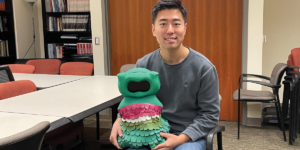
When air pollution levels are high, a smartphone app developed by USC researchers will suggest actions to reduce exposure levels, such as using the car’s air recirculation mode or taking a suggested alternative driving route to reduce exposure. Photo/iStock.
Air pollution is a major problem in large cities from Los Angeles to New Delhi, with studies linking pollutant inhalation to chronic health conditions such as asthma, the most common respiratory disease worldwide. In fact, an increase in air pollution since 2016 has caused almost 10,000 premature deaths in the U.S., with more than 40 percent in California alone.
In addition to emissions associated with car exhaust and other fumes, wildfires are a growing source of pollution from fine-particulate matter—tiny particles of soot and other materials small enough to enter the lungs and even the bloodstream.
While polluted air affects all those who breathe it, babies in the womb are at particular risk to suffer adverse birth outcomes like preterm birth and low birth rate. And yet it’s a relatively neglected and poorly understood problem.
A new project underway at the USC Viterbi School of Engineering’s Integrated Media Systems Center and the Keck School of Medicine of USC will monitor air pollution exposure in pregnant women using personal sensors fitted in a wristband.
These tiny sensors will measure levels of three major air pollution gases — nitrogen dioxide, carbon monoxide and ozone — every minute throughout pregnancy.
When air pollution levels are high, a smartphone app will suggest actions to reduce exposure levels, such as using the car’s air recirculation mode or taking a suggested alternative driving route to reduce exposure.

Cyrus Shahabi, USC computer science professor and the study’s principal investigator.
“Based on the gas readings, our app will be able to alert the user when she finds herself in an area where the gas concentration is above the threshold indicative of pollution,” said principal investigator Cyrus Shahabi, a USC Viterbi School of Engineering computer science professor.
“The app will also be able to provide a woman with practical steps she can take to limit her exposure.”
The researchers hope this emerging technology will provide new insights into how air pollution exposure during pregnancy impacts the newborn brain and to develop interventions to limit this exposure.
In addition to Shahabi, the team comprises Luciano Pasquale Nocera, a senior research associate at USC’s Integrated Media Systems Center (IMSC) and Brad Peterson, a medical doctor and professor of pediatrics and psychiatry at the Keck School of Medicine of USC.
Shahabi has been working with transportation and pollution data in partnership with the L.A. Metropolitan Transportation Authority since 2011. Their previous studies include crowdsourcing data for “smart city” applications, including improving street cleanness and fighting pollution.
Shahabi, the Helen N. and Emmett H. Jones Professor in Engineering, has also previously worked with medical professionals at USC to improve cancer treatment and monitor infants’ motor development using off-the-shelf technologies like smartphones and wristbands.
Protecting newborn brains
When a pregnant woman breathes in polluted air, the pollutant can travel from her lungs to the placenta. Attached to the wall of the uterus, the placenta passes essential oxygen between mother and baby, but it can also pass polluted air.
Many studies have revealed prenatal exposure to air pollution from vehicles may impact children’s birth weight, gestation periods and lung health after they are born and later in life. Other studies have shown that exposure to pollution while in the womb may also lead to sleep disorders and behavioral problems in children.
With this study, the team hopes to learn more about specific gases in air pollution that may be the greatest culprits in disturbing fetal and childhood brain development, along with the times during pregnancy and shortly after birth when the developing brain is most vulnerable.
“This research will clarify what these effects are, tell us what gases and pollutants are involved and give us a tool to help protect the brain of newborns from the effects of air pollution,” said Peterson, who also directs the Institute for the Developing Mind at the Children’s Hospital Los Angeles’ Saban Research Institute.
The project recently received funding from the Children’s Hospital Los Angeles to complete the pilot stage. The team has developed the app prototype; the next step is to integrate and test this with the sensors.
They hope to start testing on pregnant women volunteers in L.A. within the next year. In the meantime, because the highest pollution levels are near roadways, said Peterson, pregnant women may wish to drive with windows closed and ventilation settings on recirculate.
“On days of particularly poor air quality, or if living near roadways or other pollution sources, they may choose to spend more time indoors with the windows closed,” said Peterson.
“This may be particularly true if living near or downwind from wildfires in our region.”
Published on November 26th, 2019
Last updated on November 26th, 2019












